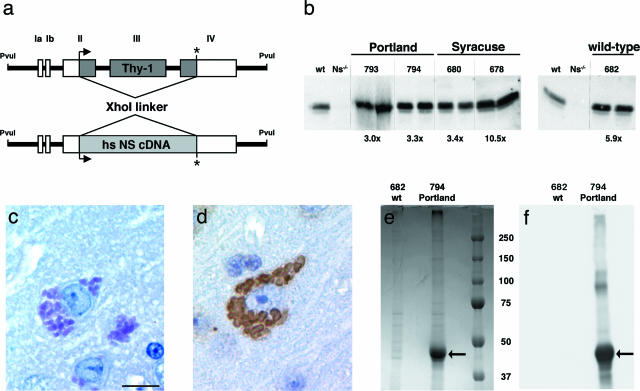Figure 1.
Generation and characterization of transgenic mice overexpressing human Portland, Syracuse, and wild-type neuroserpin. a: Schematic drawing of the DNA construct used to generate transgenic mice. The translated region of Thy-1 was replaced by neuroserpin cDNA. Relevant restriction sites are indicated. The PvuI-PvuI fragment was injected into the pronucleus of fertilized oocytes. b: Quantification of neuroserpin protein level by Western blotting of brain homogenates of mice overexpressing Portland (lines 793 and 794), Syracuse (lines 678 and 680), and wild-type neuroserpin (line 682). Two animals per line were analyzed. As a negative control, brain homogenate from a neuroserpin-deficient mutant (Ns−/−) mouse was loaded. The degree of overexpression, determined by comparing band intensities with a nontransgenic C57BL/6 mouse (wt), is indicated below each panel. PAS staining (c) and neuroserpin immunohistochemistry (d) of brain sections of a Portland transgenic mouse (line 793) aged 6 months reveals the accumulation of neuroserpin inclusions identical to those observed in FENIB patients. Coomassie blue-stained SDS-PAGE gel (e) and Western blot (f) of inclusion bodies isolated from brains of transgenic mice overexpressing Portland neuroserpin (line 794). A single band is present (arrow); it reacts positively with an affinity-purified goat antibody against neuroserpin. Molecular mass marker applies for both pictures (e and f). Scale bar in c = 100 μm.

